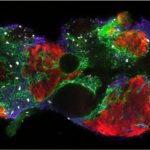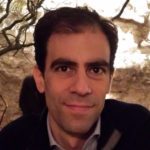When do neural stem cells activate in an adult brain? To better understand how these rare events occur and are coordinated, we developed an innovative in vivo intravital imaging of an adult zebrafish brain over several weeks. We then used pharmacological manipulations, mathematical modeling and statistical analysis to study the local and dynamic interactions controlling cell fate.
In collaboration with teams from Tel Aviv University, the École Polytechnique and INRAE, we showed that NSC activation is a spatially and temporally coordinated phenomenon. The coordination relies on short-range inhibition from transient neural progenitors, mediated by the Notch signaling pathway, but also from adjacent NSCs being previously activated. A mathematical model of these interactions shows this spatial inhibition is exerted with a delay of 9–12 days. Lastly, we demonstrate the spatiotemporal dynamics of NSC activation allows both a steady production of new neurons and the NSC population homeostasis.
This animation shows stem cells covering one of the cerebral hemispheres of an adult fish. The stem cells were monitored for 23 days to analyze their positions, activation events, and differentiation. The fish were anesthetized and filmed using a two-photon microscope every 3 days.
The dots show the center of each cell and the arrows show dividing stem cells.
© Nicolas Dray, Laure Mancini and Laure Bally-Cuif, Institut Pasteur
Source
Dynamic spatiotemporal coordination of neural stem cell fate decisions occurs through local feedback in the adult vertebrate brain, Cell Stem Cell, April 5, 2021
To read the article: here
To read the press release: here





